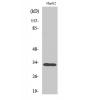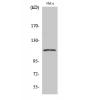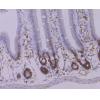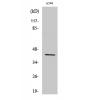Anti-ANAPC10 antibody [D10-F1]
-
概述
- 产品描述Composed of more than ten subunits, the anaphase-promoting complex (APC) acts in a cell-cycle dependent manner to promote the separation of sister chromatids during the transition between metaphase and anaphase in mitosis. APC, or cyclosome, accomplishes this progression through the ubiquitination of mitotic cyclins and other regulatory proteins that are targeted for destruction during cell division. APC is phosphorylated, and thus activated, by protein kinases Cdk1/cyclin B and polo-like kinase (Plk). APC is under tight control by a number of regulatory factors, including CDC20, CDH1 and MAD2. Specifically, CDC20 and CDH1 directly bind to and activate the cyclin-ubiquitination activity of APCs. In contrast, MAD2 inhibits APC by forming a ternary complex with CDC20 and APC, thus preventing APC activation. APC10 contains a Doc1 homology domain, which is a beta-sandwich structure common to many other putative E3 ubiquitin ligases. APC10 binds to core APC subunits throughout the cell cycle. Specifically, APC10 binds to the C-terminus of CDC27/APC3. During mitosis, APC10 is localized in centrosomes and mitotic spindles. APC10 also localizes to kinetochores from prophase to anaphase, and to the midbody in telophase and cytokinesis.
- 产品名称Anti-ANAPC10 antibody [D10-F1]
- 分子量21 kDa
- 种属反应性Human
- 验证应用WB,ICC,IHC-P,FC
- 抗体类型小鼠单抗
- 免疫原Recombinant protein
- 偶联Non-conjugated
-
性能
- 形态Liquid
- 浓度2 mg/mL.
- 存放说明Store at +4℃ after thawing. Aliquot store at -20℃ or -80℃. Avoid repeated freeze / thaw cycles.
- 存储缓冲液1*TBS (pH7.4), 1%BSA, 40%Glycerol. Preservative: 0.05% Sodium Azide.
- 亚型IgG1
- 纯化方式Protein A purified.
- 亚细胞定位Anaphase-promoting complex, cytosol, nucleoplasm
- 其它名称
- ANAPC 10 antibody
- anapc10 antibody
- Anaphase promoting complex 10 antibody
more
-
应用
WB: 1:500-1:1,000
ICC: 1:50-1:200
IHC-P: 1:50-1:200
FC: 1:50-1:100
-
Fig1: Western blot analysis of ANAPC10 on human ANAPC10 recombinant protein using anti-ANAPC10 antibody at 1/1,000 dilution.
Fig2: Western blot analysis of ANAPC10 on HEK293 (1) and ANAPC10-hIgGFc transfected HEK293 (2) cell lysate using anti-ANAPC10 antibody at 1/1,000 dilution.
Fig3: Western blot analysis of ANAPC10 on different cell lysate using anti-ANAPC10 antibody at 1/1,000 dilution.
Positive control: Line1: Hela Line2: MCF-7 Line3: SK-Br-3 Line4: A431 Line5: HEK293 Line6: A549 Line7: SPC-A-1
Fig4: ICC staining ANAPC10 (green) and Actin filaments (red) in Hela cells. The nuclear counter stain is DAPI (blue). Cells were fixed in paraformaldehyde, permeabilised with 0.25% Triton X100/PBS.
Fig5: Immunohistochemical analysis of paraffin-embedded human colon cancer tissue using anti-ANAPC10 antibody. Counter stained with hematoxylin.
Fig6: Immunohistochemical analysis of paraffin-embedded human esophageal cancer tissue using anti-ANAPC10 antibody. Counter stained with hematoxylin.
Fig7: Flow cytometric analysis of Hela cells with ANAPC10 antibody at 1/100 dilution (green) compared with an unlabelled control (cells without incubation with primary antibody; red).
特别提示:本公司的所有产品仅可用于科研实验,严禁用于临床医疗及其他非科研用途!












![Anti-ANAPC10 antibody [D10-F1]](images/202012/goods_img/92719_G_1607857911490.jpg)















